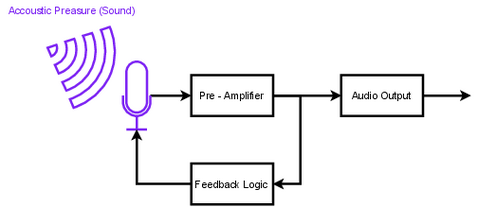This research work is part of the Listen2Future Project, funded by the German Federal Ministry of Education and Research (BMBF) and European Union.
Force Feedback MEMS Microphone
The EU-funded Listen2Future project aims to harness the potential of piezoelectric acoustic transducers to develop cutting-edge sensing solutions in the domains of health & well-being and the digital industry. One of the program’s core research areas focuses on piezoelectric MEMS microphones for medical applications, particularly in hearing aids. These devices demand an exceptionally wide dynamic range to accurately capture acoustic signals across varying sound levels, while maintaining low total harmonic distortion (THD). At the same time, energy efficiency is critical to support extended battery life in wearable form factors. Recent studies highlight the trade-off between sensitivity, linearity, and power efficiency in state-of-the-art MEMS microphone architectures [1][2].
A major design challenge arises from acoustic resonances, which are often introduced by the microphone’s enclosure and packaging and are difficult to predict using conventional modeling techniques. These resonances can degrade signal integrity and reduce intelligibility in voice-based systems. To address this, researchers at the Chair of Circuit Design (LSE), Technical University of Munich, are developing a novel MEMS microphone driver based on active force-feedback control. By dynamically feeding a portion of the amplified output signal back into the piezoelectric membrane, the system effectively dampens resonant modes and suppresses unwanted diaphragm oscillations. This feedback-loop architecture enhances linearity, expands the dynamic range, and enables the use of more compliant membranes with higher mechanical sensitivity [3].
This force feedback technique, inspired by control strategies in precision sensors and actuators, significantly improves the signal-to-noise ratio (SNR) and allows the microphone to handle higher acoustic overload points (AOP). However, introducing feedback also requires careful phase compensation to maintain loop stability, especially in the presence of parasitic delays and nonlinearities. The integration of a custom phase compensator circuit ensures robust operation across the entire audio bandwidth. As a result, this approach paves the way for next-generation MEMS microphones that combine high fidelity, low latency, and ultra-low power, promising substantial improvements for hearing aids and other bio-acoustic sensor platforms [4][5].
Reference
Luo, J., et al. "Design trade-offs in low-power MEMS microphones for portable applications." IEEE Sensors Journal, 2021.
Chen, Y. & Xu, P. "Wide dynamic range architectures in MEMS acoustic sensing." Microsystems & Nanoengineering, 2022.
Wang, T. et al. "Active feedback damping in piezoelectric transducers." Journal of Microelectromechanical Systems, 2020.
Jung, M. & Kuhl, M. "Phase compensation in MEMS-based feedback control loops." IEEE Transactions on Circuits and Systems, 2019.
Listen2Future Consortium. "Project Whitepaper: Smart Piezo-Acoustic Sensing in Healthcare and Industry", 2024.
